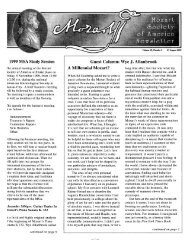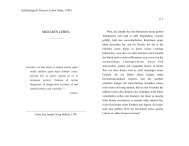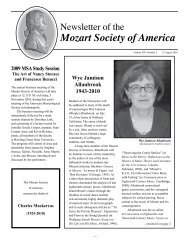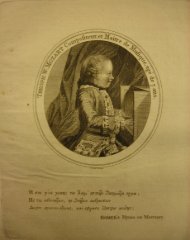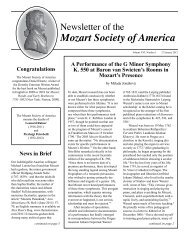January 2002 - Mozart Society of America
January 2002 - Mozart Society of America
January 2002 - Mozart Society of America
Create successful ePaper yourself
Turn your PDF publications into a flip-book with our unique Google optimized e-Paper software.
latrines, and numerous living rooms on<br />
the ground floor. On the upper floor were<br />
the bedrooms, a gallery for the chapel,<br />
and three rooms devoted to the family<br />
library. In 1791, servants included<br />
doorkeepers, gardeners, cooks, valets,<br />
ushers, a hunt master, and a dwarf.<br />
Early in 1791, an estate worker died <strong>of</strong><br />
"hitziges Faulfieber"-an acute putrid<br />
fever-and the 20-year-old Countess<br />
contracted and succumbed to the illness a<br />
short time later. She died on 14 February<br />
1791 and was buried two days later in the<br />
Walsegg family crypt, which had been in<br />
use in the Schottwien church from 1720.<br />
On 27 March, 1791, her remains were<br />
transferred with all due religious<br />
solemnity to the new tomb erected in the<br />
meadows adjacent to the castle.<br />
An 1839 report written by Anton<br />
Herzog, a schoolteacher from Wiener<br />
Neustadt, states that the tomb was<br />
"defaced by pr<strong>of</strong>ane hands, especially at<br />
the time <strong>of</strong> the hostile invasion," referring<br />
to the Napoleonic war with France. The<br />
Count died on 11 November 1827 and<br />
was buried in the Walsegg crypt in<br />
Schottwien. On the 30th, the<br />
remains <strong>of</strong> the Countess were<br />
exhumed and also moved back to<br />
the family crypt for burial alongside<br />
those <strong>of</strong> her husband. A plaque<br />
commemorating the deceased<br />
Walseggs may be seen on the<br />
church wall close to the former<br />
entrance to the crypt, sealed when a<br />
new floor was laid as part <strong>of</strong> a<br />
major restoration in 1889. On the<br />
Count's death, ownership <strong>of</strong><br />
Schloss Stuppach was acquired by<br />
the Liechtenstein family.<br />
The 1839 account, The True and<br />
Full History <strong>of</strong> the Requiem <strong>of</strong> W A.<br />
<strong>Mozart</strong>, was penned by Herzog who<br />
had first-hand knowledge <strong>of</strong> events<br />
at Schloss Stuppach. He was also a<br />
musician who played in the 14<br />
December 1793 performance <strong>of</strong> the<br />
Requiem in the Cistercian Abbey in<br />
Wiener-Neustadt, conducted by<br />
Count Walsegg and advertised as<br />
his own composition. The Count<br />
had chosen that venue since there<br />
were better resources available<br />
there.<br />
Herzog visited Stuppach and<br />
spoke to the Count two weeks<br />
before his death and only shortly<br />
after Abbe Stadler's essay, "A<br />
Defense in Favor <strong>of</strong> the<br />
Authenticity <strong>of</strong> <strong>Mozart</strong>'s Requiem," had<br />
been published. He hoped to learn more<br />
about the authorship <strong>of</strong> the disputed<br />
sections <strong>of</strong> the sacred work.<br />
Unfortunately, because the Count<br />
could add little, Herzog learned nothing.<br />
In fact, the Count had been deceived in<br />
the first instance about how much <strong>of</strong> the<br />
work was <strong>Mozart</strong>'s when it was collected<br />
from Constanze <strong>Mozart</strong> in 1792. After the<br />
Count's death a fortnight later, the secret<br />
<strong>of</strong> the whereabouts <strong>of</strong> the manuscript he<br />
owned was taken to the grave with him.<br />
For a number <strong>of</strong> years Herzog would<br />
remain silent about what he knew, though<br />
he had been urged to tell his story many<br />
times.<br />
In 1839, it was announced that the<br />
Walsegg "score for delivery" (as it<br />
became known) had been discovered, and<br />
that the Austrian<br />
National Library<br />
had purchased it.<br />
The Library<br />
already owned the<br />
two sections <strong>of</strong> the<br />
"score for<br />
completion," one<br />
<strong>of</strong> which had come<br />
from Stadler and<br />
the other from<br />
Joseph Eybler,<br />
who had initially<br />
been entrusted<br />
with the<br />
completion <strong>of</strong> the<br />
Requiem. There is<br />
a local Stuppach<br />
tradition that the<br />
Walsegg score was<br />
actually found in a<br />
gardener's house<br />
near the castle.<br />
Indeed, two drums<br />
belonging to the<br />
Walseggs were<br />
discovered by<br />
Walther Brauneis<br />
<strong>of</strong> Vienna in a<br />
nearby house in<br />
the early 1990s.<br />
With renewed<br />
interest in the<br />
topic, Herzog at<br />
last wrote his<br />
story. But when<br />
the report was<br />
inspected by the<br />
Vienna censor's<br />
<strong>of</strong>fice, permission<br />
-5-<br />
to publish it was refused. "Not allowed"<br />
is written on the back <strong>of</strong> the report. Since<br />
it was initially thought that the recently<br />
discovered score at Stuppach was entirely<br />
in <strong>Mozart</strong>'s hand (which, <strong>of</strong> course, it was<br />
not), it is likely that the library did not<br />
wish to have any account in circulation<br />
which could cause them embarrassment.<br />
It is commonly believed that Herzog's<br />
report was first published in 1964 (in<br />
edited form) by the late Otto Erich<br />
Deutsch. In fact, the report was printed on<br />
the front page <strong>of</strong> a Vienna newspaper, the<br />
Reichspost, No. 123, on 5 May 1923. The<br />
great nineteenth··century <strong>Mozart</strong><br />
biographer, Otto Jahn, also knew <strong>of</strong> the<br />
existence <strong>of</strong> Herzog's report.<br />
While the controversy on the<br />
completion <strong>of</strong> the <strong>Mozart</strong> Requiem<br />
continues unabated to this day, less<br />
Present View <strong>of</strong> Tomb Site.<br />
Tomb Site Detail<br />
continued on page 6




